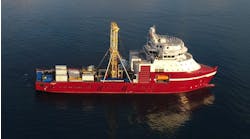Frode Sandness,TGS-Nopec
Joao Pacheco, IGM
A series of basins with sediment thickness generally in excess of 10,000 m has been outlined beyond the conventional continental shelf through integrated seismic, gravity, and magnetic interpre-tation. These basins are virtually unexplored due to past tech-nological limitations.
TGS-Nopec acquired seismic and marine gravity data, totaling some 23,300 km, in 2000-2001. Plate reconstruction and comparison of data from the conjugate margins have revealed great similarities in basin development and sediment deposition between:
- The basins on the Iberian Atlantic margin and the basins on the Grand Banks portion of the Canadian Atlantic margin
- The basins off the Algarve coast and the basins on the Pelagian Platform of North Africa.
In particular, the Sagres, Alentejo, and Peniche basins have thick sections of Triassic (including salt), Jurassic, and Lower Cretaceous sediments. The similarities to the prolific Jeanne d'Arc basin (Grand Banks) in the Mesozoic succession are very encouraging. The main source rock in the Jeanne d'Arc basin is Kimmeridgian shale, and the best reservoirs are in the Lower Cretaceous.
Petroleum systems
The factors that are necessary to form effective petroleum systems appear to be present in all the basins. Past exploration wells were drilled on the predominantly Jurassic carbonate platform and encountered tight reservoirs. The basins further offshore are interpreted to contain a much higher portion of siliciclastic sediments with better potential reservoir parameters based on seismic character. Platform bypass areas and large basinal fan systems are recognized.
The potential reservoir sections have sufficient fine-grained or muddy sediments in the overburden to provide sufficient seal. A number of potential source rocks with excellent hydrocarbon generating potential are interpreted in the basins based on regional considerations and seismic interpretation. For example, both Upper Jurassic (Kimmeridgian) and Lower Cretaceous mudstones should be deposited through major portions of the basins, and they are deeply enough buried to have generated significant amounts of hydrocarbons.
The presence of live petroleum systems in the mapped basins is substantiated by numerous seismic direct hydrocarbon indicators, oil stained dredge samples, and live oil seeps detected (by Infoterra) from satellite images.
Plays
A number of large structures have been outlined, and interesting stratigraphic plays at several levels have been identified in all the basins. At least 12 different play types have been recognized, ranging in age from Triassic to Tertiary. A seismic example from the shallow portion of the Sagres basin (water depth 750-1,500 m) shows possible stacked plays through this stratigraphic interval at the foot of the carbonate platform.
All the identified plays can be tested with available technology in the area covered by the current concession round blocks. Once discoveries are made, fields are developed, and infrastructure is in place in these areas, rapidly advancing technology will allow testing leads seen in even deeper water.
Basins
The Gulf of Cadiz basin to the south of the Faro Ridge (basement high) is dominated by the thick olistostrome. Seismic imaging is difficult because of the contorted nature of this mass flow.
The Algarve basin is the continuation of the Guadalquivir basin in Spain where biogenic gas fields are producing from Upper Miocene-Pliocene turbidites. Deeper Paleogene and Meso- zoic plays are under-explored.
The Sagres basin has a thick, totally untested sedimentary section with a variety of plays, siliciclastic and carbonate reservoirs of different age.
The Alentejo basin can be considered on trend with the onshore Lusitanian basin, but is far less inverted. It also contains a wide variety of play types, and it is virtually untested.
The Peniche basin has the best resemblance to the Mesozoic section of the Jeanne d'Arc basin. The main differences are a thin Tertiary overburden and much greater water depth. The shallowest part of the basin is on the Estremadura Spur. No wells have been drilled in the basin.
Concession round
The promising preliminary evaluation results led the Portuguese government, through the Geological and Mining Institute (IGM), to announce a bidding round for the granting of concessions in the deep offshore that opened last July. The deadline for bid submission is Dec. 2.
Fourteen blocks are being offered, ranging in size from 2,285 to 3,207 sq km. These are located in the Peniche, Alentejo, Sagres, Algarve, and Gulf of Cadiz basins. The definition of the blocks was partly done in response to nominations provided by the industry.
Contract conditions are the same for all blocks. The exploration period is eight years and can be extended twice by one year, if justified. No minimum work obligations are defined for the first three years, but a one-well commitment is set for years four, six, and eight. Termination of the contract is possible at the end of the third and subsequent years, provided that obligations are fulfilled.
The production period is 30 years and can be extended by 15 more years when justified.
There are no royalties to be paid on production. Normal corporate tax and municipal tax add up to 33% of income less deductions.
Details of the tender procedures and concession contract conditions are available on IGM's web site at www.igm.pt. More exploration details are contained in the "Offshore Port-ugal 2000 Evaluation Report" available from TGS-Nopec.
Conclusion
Several basins containing thick sedimentary sections and large structures have been mapped. Live petroleum systems are strongly indicated. Giant hydrocarbon potential is envisioned in this frontier area.
It is expected that the favorable geological evaluation, together with the advantageous contract conditions and fiscal regime, will positively offset the risks inherent to all frontier exploration and encourage the industry to try their luck in the Port-uguese deep-offshore.
After all, few "virgin areas" like these are left at the doorstep of the major European oil and gas market.







